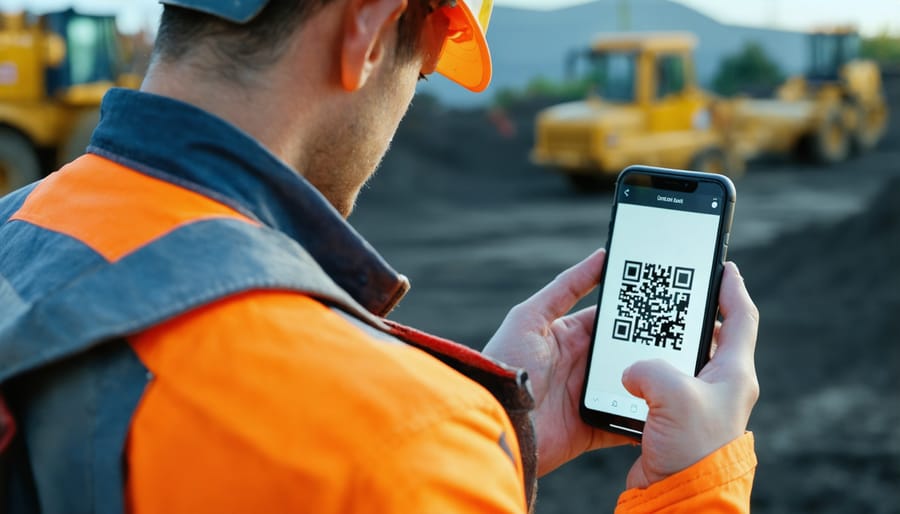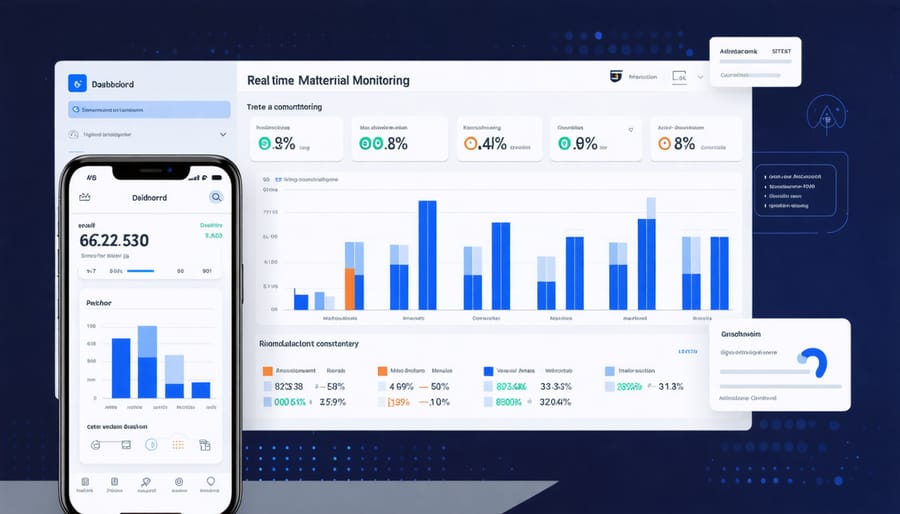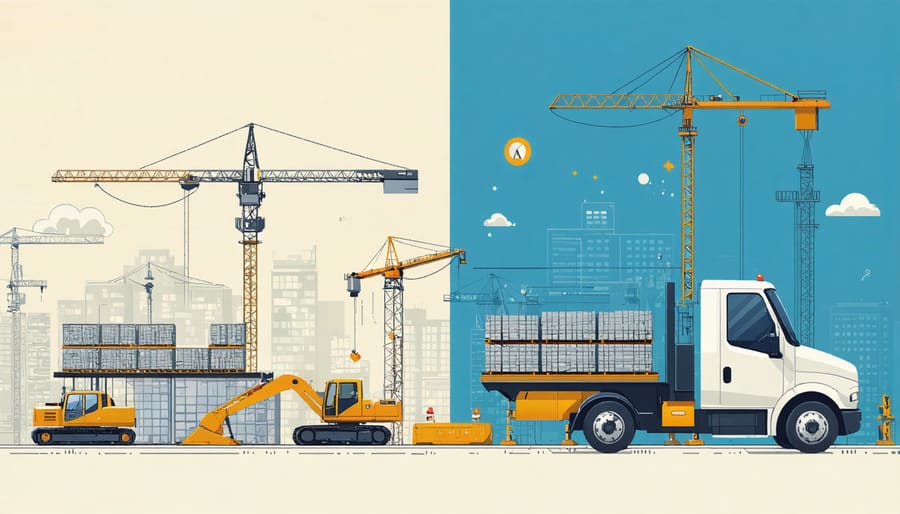In today’s digital construction landscape, rugged smartphones have become indispensable command centers for modern job sites, transforming how we manage projects, monitor smart materials, and coordinate complex construction operations. These purpose-built devices combine military-grade durability with sophisticated sensors and construction-specific applications, enabling real-time material tracking, structural monitoring, and seamless team communication across even the most challenging work environments. As smart materials and IoT integration reshape construction methodologies, these specialized mobile devices serve as critical interfaces between physical infrastructure and digital project management systems, offering unprecedented control over material performance, safety protocols, and quality assurance. Industry leaders leveraging these robust mobile solutions report up to 40% improvements in workflow efficiency and a 25% reduction in material waste through enhanced tracking capabilities. With construction smartphone technology evolving rapidly to incorporate advanced features like thermal imaging, augmented reality for BIM visualization, and AI-powered material analysis, these devices have become essential tools for forward-thinking construction professionals committed to maximizing project outcomes and embracing the future of smart construction.
Smart Material Integration with Mobile Technology
Sensor Technology and Data Collection
Modern construction smartphones integrate sophisticated sensor technology to enhance jobsite monitoring and data collection capabilities. IoT sensors in construction work seamlessly with smartphones through advanced connectivity protocols, including Bluetooth Low Energy (BLE) and WiFi Direct, enabling real-time data transmission and analysis.
Key sensors commonly found in construction-focused smartphones include accelerometers for motion detection and tool tracking, gyroscopes for precise orientation measurements, and environmental sensors that monitor temperature, humidity, and air quality. These devices also feature high-precision GPS modules for accurate positioning and geolocation services, essential for site surveying and asset tracking.
Advanced smartphones now incorporate LiDAR sensors for 3D scanning and measurements, while integrated barometric pressure sensors assist in elevation tracking and vertical positioning. The combination of these sensors with powerful mobile processors enables immediate data processing and analysis directly on the device, facilitating quick decision-making and enhanced project oversight.
Data collected through these sensors is typically encrypted and transmitted to cloud-based platforms, ensuring secure storage and enabling comprehensive analysis across multiple project parameters.

Real-time Material Monitoring
Modern smartphones have revolutionized material monitoring in construction, offering real-time insights through advanced sensors and dedicated applications. These devices enable contractors and site managers to track crucial material parameters such as temperature, moisture content, and structural integrity through integrated IoT sensors. Among various construction site monitoring innovations, smartphone-based solutions stand out for their accessibility and ease of implementation.
Project teams can now monitor concrete curing conditions, track steel reinforcement placement, and assess material performance through their mobile devices. Advanced applications utilize smartphone cameras and sensors to detect potential issues like thermal bridging or moisture infiltration, allowing for immediate corrective action. The data collected is automatically synchronized with project management platforms, creating comprehensive material performance logs.
This technology proves particularly valuable for quality control teams, enabling them to document material conditions, verify compliance with specifications, and maintain detailed records for future reference. The integration of augmented reality features further enhances this capability, allowing workers to visualize material specifications and installation requirements in real-time through their smartphone screens.
Key Features of Construction Smartphones
Material Analysis Apps
Material analysis applications have revolutionized on-site testing and quality control processes in modern construction. These specialized apps, working in conjunction with smart building technology, enable contractors and engineers to perform real-time material assessments directly from their smartphones.
Leading applications in this category include concrete testing tools that analyze curing conditions, strength development, and moisture content through connected sensors. Advanced spectrometer apps can identify material compositions and verify compliance with project specifications by analyzing surface properties through the phone’s camera.
These apps often integrate with laboratory information management systems (LIMS), allowing seamless documentation of test results and immediate sharing with project stakeholders. Quality control managers can track material performance trends, generate compliance reports, and maintain digital records for future reference.
Particularly noteworthy are applications featuring augmented reality capabilities for non-destructive testing. By overlaying digital information onto physical materials, these tools can detect potential defects, measure material density, and assess structural integrity without compromising the construction elements.
The integration of machine learning algorithms enables these apps to provide increasingly accurate analysis over time, learning from historical data to improve material performance predictions and quality assessments.

Cloud Integration and Data Management
Cloud integration has revolutionized how construction professionals manage and analyze material data through their smartphones. Modern construction apps leverage cloud infrastructure to create seamless connectivity between field operations and office management, enabling real-time data synchronization and collaborative decision-making.
These cloud-based systems facilitate instant access to material specifications, safety data sheets, and inventory levels directly from mobile devices. Project managers can track material usage, monitor supply chains, and generate automated reports through sophisticated data management platforms. The integration of cloud services also enables predictive analytics for material consumption patterns and waste reduction strategies.
As construction projects become increasingly data-driven, proper digital infrastructure security becomes paramount. Cloud platforms incorporate robust encryption protocols and multi-factor authentication to protect sensitive project information while maintaining accessibility for authorized personnel.
Advanced cloud solutions also facilitate Building Information Modeling (BIM) integration, allowing teams to access and modify 3D models through their smartphones. This capability enables on-site verification of material specifications and immediate updates to project documentation. The system’s ability to maintain version control and track changes ensures accountability and reduces errors in material management processes.
Furthermore, cloud integration supports automated workflow management, enabling smart notifications for material delivery schedules, quality control alerts, and inventory replenishment triggers. This proactive approach to material management helps prevent project delays and optimizes resource allocation across construction sites.

Practical Applications on Construction Sites
Quality Control and Verification
Modern smartphones have revolutionized quality control processes in construction, particularly when dealing with smart materials. Construction professionals now leverage advanced mobile applications and integrated sensors to verify material specifications and monitor performance metrics in real-time.
Using specialized verification apps, site engineers can instantly analyze smart material properties such as self-healing concrete’s crack-filling capabilities or thermochromic glass’s temperature-responsive behavior. These applications utilize the smartphone’s built-in cameras and sensors to capture detailed imagery and environmental data, comparing them against manufacturer specifications and project requirements.
Construction professionals employ smartphone-based verification tools to conduct non-destructive testing, measure material thickness, and assess structural integrity. Through augmented reality features, they can overlay digital information onto physical materials, ensuring proper installation and performance characteristics meet design specifications.
Quality control teams utilize cloud-connected mobile devices to document testing procedures, maintain digital records, and share results instantly with stakeholders. Smart material sensors communicate with smartphones via Bluetooth or NFC technology, providing continuous monitoring of critical parameters such as temperature, humidity, and stress levels.
Case studies have shown that smartphone-based quality control systems reduce verification time by up to 60% while improving accuracy and documentation consistency. For instance, a recent high-rise project in Singapore implemented smartphone-based verification for smart glass installation, resulting in zero material-related defects and significant cost savings.
The integration of artificial intelligence and machine learning algorithms enhances smartphones’ capability to detect potential material failures or performance issues before they become critical, enabling proactive maintenance and ensuring long-term reliability of smart materials in construction projects.
Project Timeline Optimization
Construction smartphone technology has revolutionized project timeline management, enabling real-time optimization of schedules and resource allocation. Through integrated project management applications, construction teams can now track progress, identify bottlenecks, and adjust timelines instantly from their mobile devices.
Studies show that implementing smartphone-based project management solutions reduces scheduling conflicts by up to 35% and improves material deployment efficiency by 28%. Project managers can monitor multiple construction sites simultaneously, receiving instant notifications about schedule variances and resource availability.
Advanced scheduling algorithms, accessible through smartphone interfaces, automatically analyze project dependencies and suggest optimal timing for various construction phases. This dynamic scheduling capability allows for immediate adjustments when unexpected delays occur, minimizing their impact on overall project completion.
Material deployment has become significantly more efficient through smartphone-enabled inventory tracking systems. Construction teams can monitor material usage in real-time, automate reordering processes, and coordinate deliveries precisely when needed. This just-in-time approach has reduced on-site storage requirements by up to 40% and decreased material waste by 25%.
GPS integration in construction smartphones enables precise tracking of equipment and materials, ensuring resources are deployed exactly where and when they’re needed. Project managers can visualize resource movement patterns and optimize deployment routes, leading to a 20% reduction in equipment idle time.
The technology also facilitates better coordination between different trades and subcontractors. Through shared digital calendars and automated notification systems, teams can synchronize their activities more effectively, reducing workflow disruptions and accelerating project completion timelines by an average of 15%.
Future Developments and Industry Impact
Emerging Technologies
The construction industry stands at the cusp of a technological revolution in smartphone integration with smart materials. Advanced sensor technologies are being developed to enable smartphones to detect material stress, temperature variations, and structural integrity through simple surface contact. These innovations will allow real-time monitoring of concrete curing processes and early detection of potential structural issues.
Quantum dot technology is emerging as a game-changer, with researchers developing smart coatings that can be scanned by smartphone cameras to reveal microscopic structural changes. This technology promises to transform how we assess material degradation and structural health in real-time.
Artificial Intelligence-powered material recognition systems are being integrated into construction-specific smartphone apps, enabling instant identification and verification of building materials through camera feeds. This advancement will significantly reduce material mixing errors and enhance quality control processes.
Another promising development is the integration of augmented reality (AR) with smart material interfaces. Next-generation smartphones will project real-time material performance data directly onto construction elements, allowing workers to visualize stress points, thermal patterns, and moisture content without additional equipment.
Furthermore, blockchain technology is being incorporated into smartphone-based material tracking systems, ensuring transparent and tamper-proof documentation of material properties, testing results, and certification data throughout the construction lifecycle. This integration will revolutionize material authentication and quality assurance processes on construction sites.
Industry Adoption Trends
Recent industry surveys indicate that over 85% of construction professionals now use smartphones as essential tools on job sites, marking a significant shift from traditional methods. This adoption rate has grown steadily at approximately 12% annually over the past five years, with particularly strong implementation among medium to large construction firms.
The trend shows increasing integration of specialized construction apps and software solutions, with project management and material tracking applications leading adoption rates. Construction companies report a 23% improvement in communication efficiency and a 17% reduction in documentation errors after implementing smartphone-based workflows.
Looking ahead, industry analysts predict that by 2025, smartphone integration will become standard practice across all major construction projects. The focus is shifting toward advanced features such as augmented reality for design visualization, real-time sensor integration for safety monitoring, and artificial intelligence-powered decision support systems.
Notable emerging trends include the adoption of cloud-based collaboration platforms accessible via smartphones, increasing use of mobile-first safety inspection protocols, and integration with Building Information Modeling (BIM) systems. Construction firms are also investing in custom mobile applications tailored to their specific workflow requirements.
However, challenges remain in areas such as data security, device durability in harsh construction environments, and standardization of mobile processes across different project stakeholders. Industry leaders are actively addressing these concerns through improved hardware specifications and robust security protocols.
The integration of construction smartphones in smart material management has revolutionized how construction projects are executed and monitored. These devices have become indispensable tools, transforming traditional material tracking methods into sophisticated, data-driven processes that enhance efficiency and reduce waste. The ability to access real-time information, coordinate deliveries, and monitor material usage through mobile technology has significantly improved project outcomes and resource allocation.
Looking ahead, the role of construction smartphones in smart material management will continue to expand. The emergence of advanced sensors, artificial intelligence, and Internet of Things (IoT) integration promises even greater capabilities for material tracking and optimization. Construction professionals can anticipate more sophisticated applications that offer predictive analytics for material needs, automated inventory management, and enhanced supply chain visibility.
The economic impact of this technological integration cannot be understated. Companies implementing smartphone-based smart material management systems consistently report substantial cost savings, improved productivity, and better environmental performance. As sustainability becomes increasingly crucial in construction, these mobile solutions will play a vital role in reducing material waste and optimizing resource utilization.
For construction industry leaders, embracing and investing in smartphone technology for material management is no longer optional but essential for maintaining competitiveness and meeting modern project demands. The future of construction material management lies in the continued evolution of these mobile solutions, promising even greater integration with emerging technologies and improved project outcomes.

